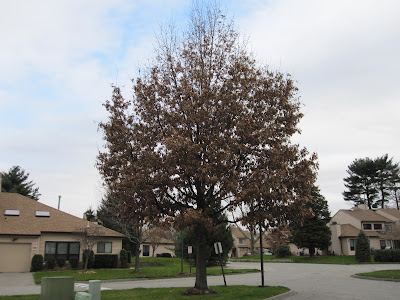
Fall has arrived and the leaves have fallen...or have they!
Trees typically loose their leaves in the fall and signal the changing of seasons. Sometimes the complexities and variability of climate can trick trees into not loosing their leaves. The trees individual circumstances can prevent their leaves from falling as well.
The primary process at work in leaf drop is abscission. The term abscission is from the Latin, Ab meaning away, and sciendere, to cut , “ to cut away”. You needn't wait until fall to see this process in action as it happens all the time in woody plants, every time a flower or piece of fruit falls from a branch.
Fall leaf drop is by far the most spectacular example of abscission at work.
Leaf drop and the formation of the abscission layer, a group of cells at the base of each leaf, is controlled largely by day length and its effects on the production of the plant hormone auxin.
Actively growing leaves produce auxins and they are translocated through the petiole and into the branch that the leaf is attached to. The presence of auxin suppresses the cells forming the abscission layer and prevents them from expanding. As the leaf ages and day length decreases it reaches a point where it no longer produces enough auxin to suppress the growth of the cells and they expand. This expansion closes off the passage from leaf to stem and the leaf is cut away from the stem. This is the complete process of abscission. Sometimes early frosts, or and late summer rains encouraging new growth, resulting in partial leaf drop. This incomplete abscission is unusual but not unheard of.
Typically the leaves eventuality fall off a few weeks later, thwarting our efforts for a timely fall clean up!
The same process allows trees like birches and box elders to loose some of their leaves during times of drought. It is quite normal to see birches loose a noticeable amount of foliage in mid to late summer. Trees that die suddenly due to injury or disease may not lose any of their leaves, this is a diagnostic characteristic of Dutch elm disease.
Evergreens such as spruce and pine do loose there needles continuously through out their lives typically in the early fall of the year.
Most evergreens keep their needles for three seasons. When stressed they may lose many of their second year needles as well.
There are some trees, oaks, beeches and hornbeams, that have developed a different strategy and will retain some of their leaves throughout the winter.This phenomenon is called marcescence. This is very common in younger trees and is there fore considered a juvenile trait, one that some trees grow out of. Marcesesnce may provide some protection from roaming deer and moose that live on buds and trigs through the winter. Buds that are protected from browsing by dead leaves may survive to grow next season. The retained leaves may provide protection from dessication in areas with harsh winter winds.
If have trees that have failed to loose their leaves and are concerned with their health contact your Certified Arborist.


No comments:
Post a Comment